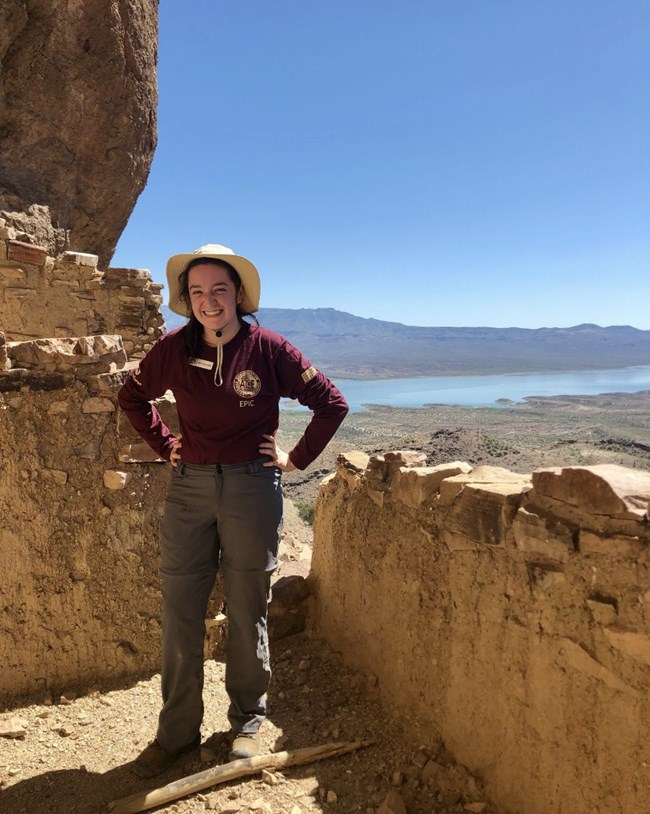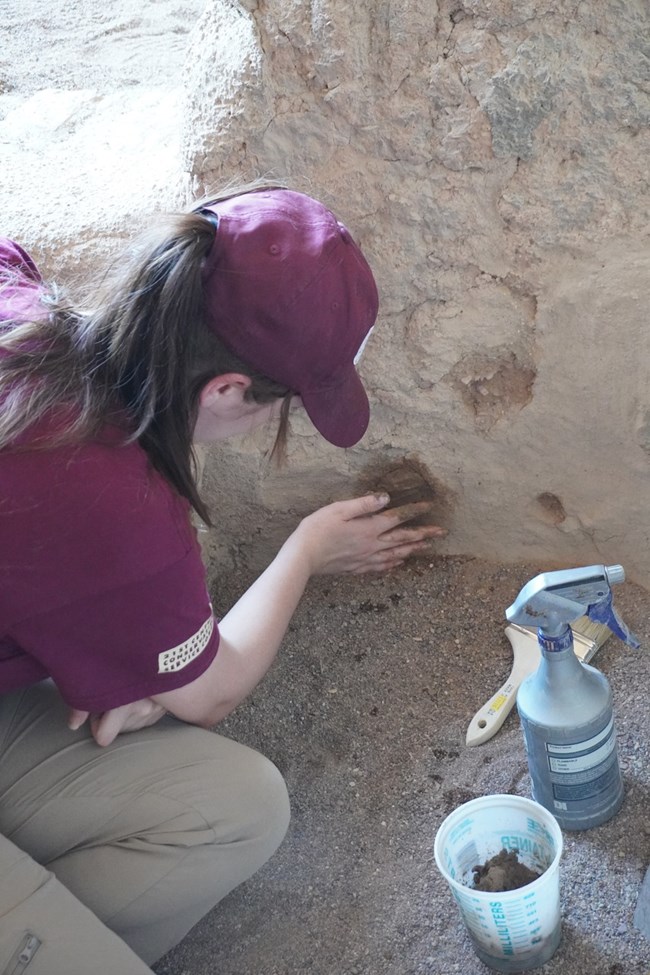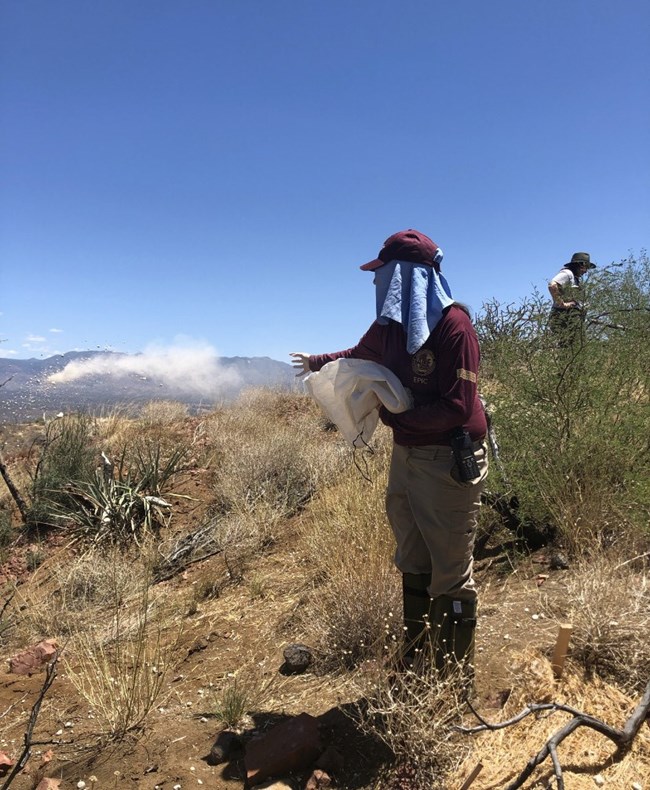Last updated: September 21, 2022
Article
Intern and Fellow Highlights: Julia Coverdale

Courtesy of Julia Coverdale
You may have heard of cultural resources, but what exactly does this work entail and what type of work do interns and fellows do? Find out through this intern and fellow highlight series that features the work of our interns and fellows service wide.
Everyone has a personal connection to cultural resources. Cultural resources help us define what makes us human through understanding the evidence we leave behind and continue to create today. This can include anything from archives, archaeological sites, museum collections, structures and cultural landscapes, and resources with significance to a group of people traditionally associated with them.
To learn more about cultural resources, visit the Cultural Resources, Partnerships, and Science Directorate page.
So... What exactly does a cultural resource internship look like?
Interns and fellows work with multiple offices, programs, and parks through partner organizations such as the American Conservation Experience (ACE) and National Council for Preservation Education (NCPE). They work on various projects that range from tribal consultation and policy to telling the stories of women in World War II and even to connecting local communities with public history.
Their work adds value to the National Park Service and supports our mission to preserve for the enjoyment, education, and inspiration of this and future generations.
Meet Julia Coverdale (they/them), who is the American Conservation Experience (ACE) Cultural Resources Diversity, Cultural Resources Preservation Assistant Intern at Tonto National Monument.

Courtesy of Julia Coverdale
Tell me a bit about yourself?
Hello! I’m Julia Coverdale and I’m a Senior at Kansas State University studying anthropology, history, and queer studies. I’ve been interested in archaeology ever since I was young, after I visited Mesa Verde with my family on a road trip to the Grand Canyon. I fell in love with archaeology in the southwest, and during high school I participated in multiple programs with Crow Canyon Archaeological Center, such as their High School Field School, where I got to participate in excavations and grew even more passionate about archaeology. In college, I’ve excavated at the Point Pueblo Great House site for field school and presented at the Pecos Conference. For the past year, I worked in the Archaeology Lab at K-State as a Collections Assistant, where I have done all sorts of work to help organize the collections we house, such as take an inventory of the White Rock site in order to prepare it for returning to the Nebraska State Historical Society. I also currently work at Hale Library, the main library at K-State, as a Library User Services Student Specialist where I mainly assist with questions at the front desk. I’m also quite involved in student organizations at Kansas State. I have served as the Secretary for the Anthropology Club for two years. I was also the Vice President of the Sexuality and Gender Alliance last year and am the current President. My involvement in SAGA, my Queer Studies courses, and simply my life experiences as a nonbinary lesbian has led me to becoming passionate about diversity issues on campus. I was the Diversity Chair for the College of Arts and Sciences Ambassadors last year, and in that position, I planned the college’s Diversity Summit. In my free time, I love to read and do outdoors activities, like hiking and camping!
Tell us a little bit about what you do in your position?
In my position as the Cultural Resources Preservation Assistant at Tonto National Monument, I mainly was working on updating the Cliff Dwelling Preservation database which lists all of the preservation work that has occurred on the Upper and Lower Cliff Dwelling since the Monument’s establishment in 1907. The database had not been updated since its creation in 2006, so I had to update it with the past sixteen years of work on each wall of the dwelling. I also helped conduct site monitoring, and for one of the sites we monitored we put down jute matting and seeds to help prevent the site from eroding down the hillside. Another preservation task that I helped with was applying new mortar to the voids in the walls of the Lower Cliff Dwelling, which was really just repairing old preservation work. I also helped with taking wall assessment pictures of the Upper Cliff Dwelling, which will be used to inform future preservation work. One of my final projects was to begin gathering information for an Archaeology 101 document for future interpretation training use. In addition to my preservation and archaeology-related duties, I also assisted with natural resources duties like taking daily weather readings, changing air quality filters, and changing and checking game cameras and occasionally staffed an interpretation shift at the Lower Cliff Dwelling.
If you met a younger version of yourself, what would you tell them about your current career trajectory?
I would tell them everything. One of the things that struck me so deeply in this position, especially when out in the field at one of the cliff dwellings, is just how surreal it is to have working on these sites be your job. I know that younger me would be so deeply in awe of where I am now and the work I have gotten to do, and that certainly hit me a lot in this position. I fell in love with archaeology by visiting cliff dwellings, and it feels poetic to end up at Tonto National Monument working on these dwellings. I would also tell myself about my mistakes in my career and hope that I learn from them so that I don’t repeat them. I would warn them about the ethical issues in archaeology that I will encounter and how to deal with them, as well as how to do my best to avoid them. But mostly I think I would show them how my life is now, and that if they get through the hard part their life will be the coolest ever and everything they ever imagined. Also, get very used to driving!

Courtesy of Julia Coverdale
How do you see the field of cultural resources changing in the coming years?
I think one of the ways cultural resources will change in coming years is through listening to and following through on the concerns and agreements made with descendant communities. Generally, I think much of the field has been moving in this direction but the outliers who have not are truly a dark spot in the field. I think one of the best ways to push the entire field into listening to indigenous communities is through not working with those people and companies who do not. By listening to and working with these unethical people, we are putting a stamp of approval on their practices whether we want to or not. Just because it is legal, does not mean it is right! I also think the field is becoming more and more diverse, which will help move us towards better relations with descendant communities. Most of the people I know going into archaeology, especially in the United States, are queer people so I truly see cultural resources becoming queerer and queerer with every new generation of archaeologists.
Where do you see yourself in the future?
I have lots of different hopes for my future. For a long time, I have hoped to go to graduate school to get a PhD in anthropology and become a professor. I truly love researching in archaeology, the entire process really, because I love how it makes me think deeply and in new ways about new things. However, my internship as the Cultural Resources Preservation Assistant at Tonto National Monument has truly shown me that if my long thought out plan does not end up working out, I would be happy to spend my life working in cultural resources for the National Parks Service. This position has helped me realize that if my long-held hopes for the future don’t work out, that I will be okay and still be able to do work that I love.
For more information on CRPS internship programs contact Paloma Bolasny at e-mail us
For more information on youth and young adult programs and opportunities in the National Park Service, visit Youth Programs (U.S. National Park Service) (nps.gov)
